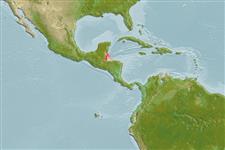>
Blenniiformes (Blennies) >
Chaenopsidae (Pike-, tube- and flagblennies)
Etymology: Acanthemblemaria: Greek, akantha = thorn + Greek, emblema, -atos, anything that is nailed, knocked in; also anything with bass or high relief (Ref. 45335).
Eponymy: Paula is Latin for ‘little’, and is in reference to the species’ diminutive size. [...] (Ref. 128868), visit book page.
Environment: milieu / Zona climática / intervalo de profundidade / distribution range
Ecologia
marinhas associadas(os) a recifes; intervalo de profundidade 1 - 2 m (Ref. 13293). Tropical; 18°N - 15°N, 90°W - 86°W (Ref. 56275)
Western Central Atlantic: Belize.
Comprimento de primeira maturação / Tamanho / Peso / Idade
Maturidade: Lm 1.4, range 1 - ? cm
Max length : 1.8 cm SL macho/indeterminado; (Ref. 51564)
Espinhos dorsais (total) : 18 - 20; Espinhos anais: 2. Species distinguished by: well-developed cranial spines (not short and blunt) on nape posterior to orbital flange in 2 groups (one group on each side of the dorsal midline), each group with 8 to 11 spines; patch of cranial spines on nape ends anterior to supratemporal commissural pore; inner rim of posterior infraorbital bone smooth; dorsal-fin spines 18 to 20; total dorsal-fin elements usually 38 or fewer; nasal cirri with fewer than 6 (usually 2 or 3) free tips on each side; supraorbital cirrus moderately to strongly branched; two or more rows of teeth on each palatine bone; no large, eye-diameter sized dark blotch on side of head posterior to eye; black spot present or absent in spinous dorsal fin; no white stripe along ventral midline of head in life. Common amongst Chaenopsids: small elongate fishes; largest species about 12 cm SL, most under 5 cm SL. Head usually with cirri or fleshy flaps on anterior nostrils, eyes, and sometimes laterally on nape; gill membranes continuous with each other across posteroventral surface of head. Each jaw with canine-like or incisor-like teeth anteriorly; teeth usually also present on vomer and often on palatines (roof of mouth). Dorsal-fin spines flexible, usually outnumbering the segmented soft rays (numbering 7 to 37), spinous and segmented-rayed portions forming a single, continuous fin; 2 flexible spines in anal fin; pelvic fins inserted anterior to position of pectoral fins, with 1 spine not visible externally and only 2 or 3 segmented (soft) rays; all fin rays, including caudal-fin rays, unbranched (simple). Lateral line absent. Scales absent (Ref.52855).
Body shape (shape guide): elongated.
Lives in burrows made by invertebrates (usually those of sipunculids) in dead corals in shallow water (<5 m) (Ref. 51564).
Ciclo de vida ou comportamento de acasalamento
Maturidade | Reprodução | Desova | Ovos | Fecundidade | Larvas
Springer, V.G. and T.M. Orrell, 1996. Catalog of type specimens of recent fishes in the National Museum of Natural History, Smithsonian Institution, 5: Chaenopsidae, Clinidae, Dactyloscopidae, Labrisomidae, and Tripterygiidae. Smithson. Contrib. Zool. 576:38. (Ref. 13293)
Status na Lista Vermelha da UICN (Ref. 130435: Version 2025-1)
Ameaça para os humanos
Harmless
Uso pelos humanos
Ferramentas
Relatórios especiais
Baixar XML
Fontes da internet
Estimates based on models
Índice de diversidade filogenética (Ref.
82804): PD
50 = 0.5000 [Uniqueness, from 0.5 = low to 2.0 = high].
Bayesian length-weight: a=0.00525 (0.00219 - 0.01260), b=3.06 (2.85 - 3.27), in cm total length, based on LWR estimates for this (Sub)family-body shape (Ref.
93245).
Nível Trófico (Ref.
69278): 3.0 ±0.4 se; based on size and trophs of closest relatives
Fishing Vulnerability (Ref.
59153): Low vulnerability (10 of 100).
🛈
